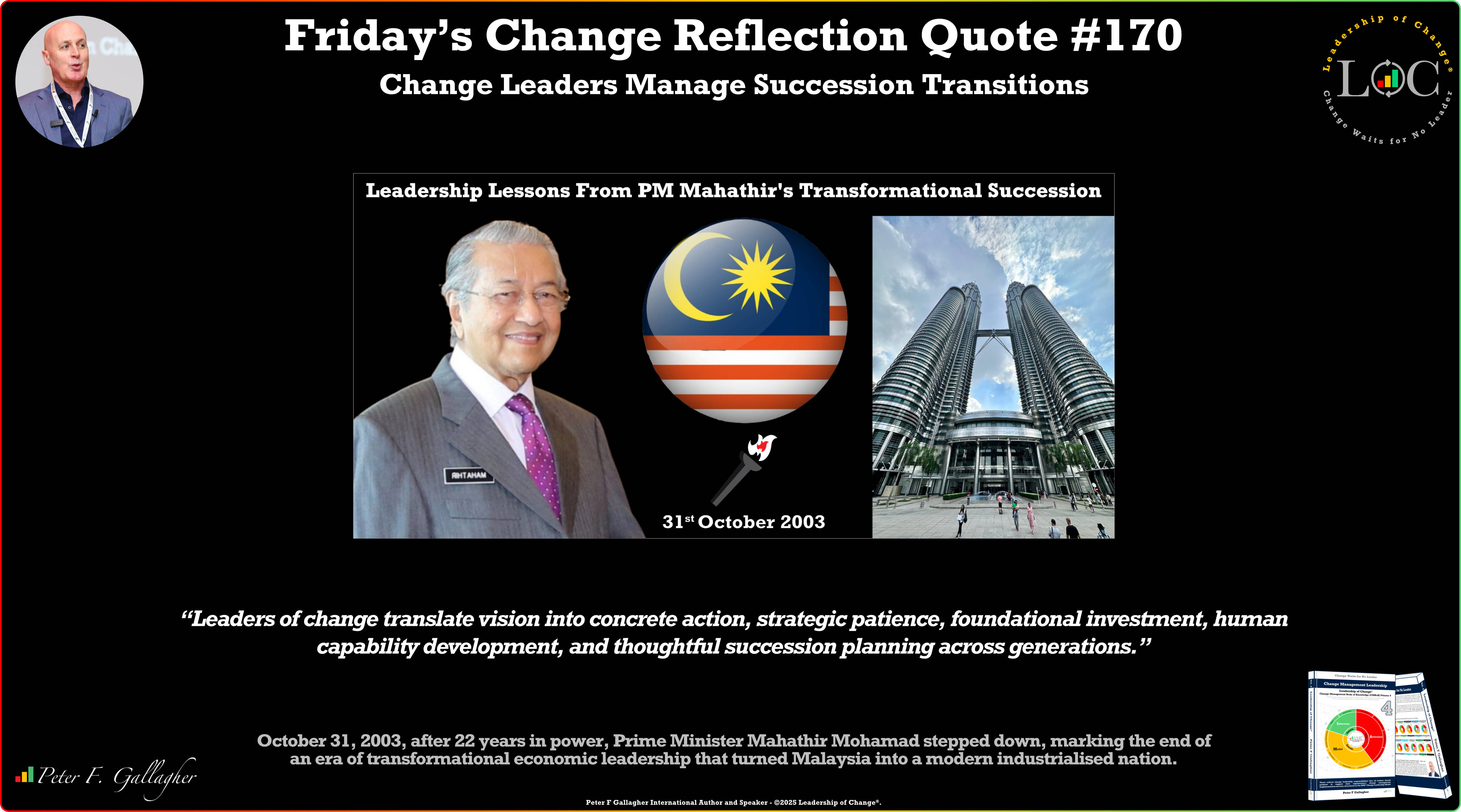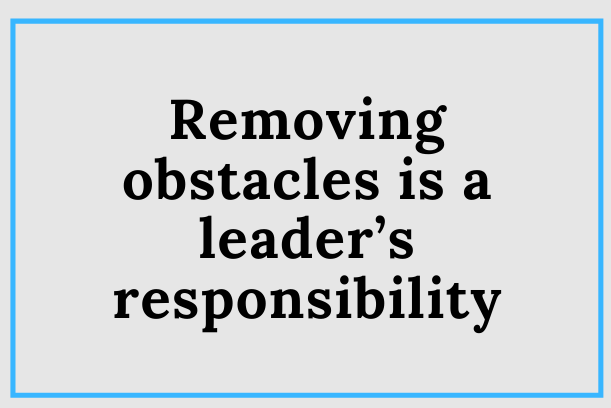Oct31

FCRQ170 Leadership Learning!
On this day, October 31, 2003, after 22 years in power, Prime Minister Mahathir Mohamad stepped down, marking the end of an era of transformational economic leadership that turned Malaysia into a modern industrialised nation. His tenure witnessed dramatic infrastructure development, export diversification, and bold state-led industrial policies that reshaped Malaysia’s economy and societal expectations. For over two decades, Mahathir’s leadership propelled Malaysia from commodity dependence towards manufacturing, services, and high-value sectors. Through privatisations, deregulation, and selective state investment, he transformed telecommunications, utilities, and the national airline industry. By the time he resigned, Malaysia had carved a place for itself among emerging economies, trading widely, and attracting international capital and technology flows. His successor, Abdullah Ahmad Badawi, assumed office with the promise of continuity, yet he inherited the weight of high expectations and the legacy of concentrated power and bold intervention. The transition represented not just a change of leader, but a pivotal structural shift in Malaysia’s modernisation story. A leader who had guided and driven much of Malaysia’s modernisation was stepping aside, leaving behind institutions, economic direction, and unresolved tensions between state control and market forces. The handover was formal, dignified, even ceremonious, undertaken before the King in Kuala Lumpur, but it carried symbolic weight — signalling change not just of person but of era. It posed questions for the nation: who would carry forward the momentum, and under what style of leadership? That moment invites reflection on how deeply leadership becomes woven into national identity and progress trajectories. The act of stepping down after such a long tenure invites reflection on legacy — both the positive transformations and the systemic dependencies created. The moment underscores that real change depends not solely on one leader but on institutions, stakeholder alignment, and adaptability to new conditions. At the end, that 2003 handover is a capsule of transition: a consummation of a generational leadership era and the beginning of a test for renewal. Its importance lies in reminding us that leadership must eventually allow change to continue beyond its own tenure. The impact ripples into governance, economic direction, and the story a nation tells about its past and future. Successor leaders must navigate the legacy, not simply inherit power. In that sense, the event is a fertile ground for change leadership reflection—for how to steward continuity, enable new voices, and ensure that institutions—not just individuals—carry forward transformation. History is not static. The 2003 transfer of power revealed both the tangible gains and the fragilities of centralised control. The enduring test of leadership is the ability to recalibrate after foundational eras, enabling new growth paths while honouring the past.
Change Leadership Lessons: This moment of succession highlights how leadership continuity must be managed deliberately, ensuring transformation outlives the individual. Just as Mahathir’s transition tested the endurance of Malaysia’s transformation, change leaders must intervene early to institutionalise knowledge, clarify governance, and align stakeholders around enduring principles rather than personalities. Leaders of change turn broad aspirations into clear actions that people can understand and apply in daily decisions, creating real progress toward future goals. They keep long-term focus beyond short-term results, staying consistent in strategy but flexible as conditions evolve. Change leaders build the foundations and capabilities that drive future performance, accepting short-term costs for long-term strength and resilience. They grow people’s skills and confidence to deliver new ways of working and sustain results beyond the initial change. Leaders of change prepare successors, capture knowledge, and build systems that outlast individuals, ensuring continuity through leadership transitions. Change Leaders Manage Succession Transitions.
“Leaders of change translate vision into concrete action, strategic patience, foundational investment, human capability development, and thoughtful succession planning across generations.”
Application - Change Leadership Responsibility 3 - Intervene to Ensure Sustainable Change: Mahathir’s departure in 2003 reminds change leaders that sustainable transformation depends not only on what is achieved during a leader’s tenure, but on how leadership transitions are managed. This responsibility requires deliberate intervention to ensure continuity, capability, and confidence across generations of leadership. Effective succession never happens by chance; it is designed through foresight, preparation, and organisational resilience. Change leaders must intervene early to institutionalise knowledge, clarify governance, and align stakeholders around enduring principles rather than personalities. They ensure that strategy, values, and accountability are embedded within structures that outlast individual influence. When transitions are left unmanaged, organisations risk fragmentation, uncertainty, and the loss of hard-won progress. Intervening for sustainable change means balancing legacy with renewal, preserving what has been built while fostering new leadership energy and innovation. Leaders who embrace this responsibility recognise that their greatest success lies in enabling others to advance the change journey with clarity, cohesion, and conviction.
Final Thoughts: In an era of constant transformation, succession transitions must be led with intention, not left to chance. Sustainable change depends on leaders who embed adaptability, accountability, and renewal within their organisations. True success is measured not by tenure, but by how confidently others continue the transformation.
Further Reading: Change Management Leadership - Leadership of Change® Volume 4.
Peter F. Gallagher consults, speaks, and writes on Leadership of Change®. He works exclusively with boards, CEOs, and senior leadership teams to prepare and align them to effectively and proactively lead their organisations through change and transformation.
For insights on navigating organisational change, feel free to reach out at Peter.gallagher@a2B.consulting.
For further reading please visit our websites: https://www.a2b.consulting https://www.peterfgallagher.com Amazon.com: Peter F Gallagher: Books, Biography, Blog, Audiobooks, Kindle
Leadership of Change® Body of Knowledge Volumes: Change Management Body of Knowledge (CMBoK) Books: Volumes 1, 2, 3, 4, 5, 6, 7, 8, 9, 10, A, B, C, D & E available on both Amazon and Google Play:
~ Leadership of Change® Volume 1 - Change Management Fables
~ Leadership of Change® Volume 2 - Change Management Pocket Guide
~ Leadership of Change® Volume 3 - Change Management Handbook
~ Leadership of Change® Volume 4 - Change Management Leadership
~ Leadership of Change® Volume 5 - Change Management Adoption
~ Leadership of Change® Volume 6 - Change Management Behaviour
~ Leadership of Change® Volume 7 - Change Management Sponsorship
~ Leadership of Change® Volume 8 - Change Management Charade
~ Leadership of Change® Volume 9 - Change Management Insanity
~ Leadership of Change® Volume 10 - Change Management Dilenttante
~ Leadership of Change® Volume A - Change Management Gamification - Leadership
~ Leadership of Change® Volume B - Change Management Gamification - Adoption
Keywords: Business Strategy, Change Management, Leadership
 Are You Setting The Direction?
Are You Setting The Direction? There Seems to be Some Confusion: Exit vs Succession
There Seems to be Some Confusion: Exit vs Succession  When Strategy Fails, Look Inside
When Strategy Fails, Look Inside The Modular Ascent: Integrating Gemini 3, V-JEPA, and World Models for Aviation AGI
The Modular Ascent: Integrating Gemini 3, V-JEPA, and World Models for Aviation AGI Mark Lynd's 2026 Cybersecurity Predictions
Mark Lynd's 2026 Cybersecurity Predictions